Asus Zenbook UX305 Review
12:21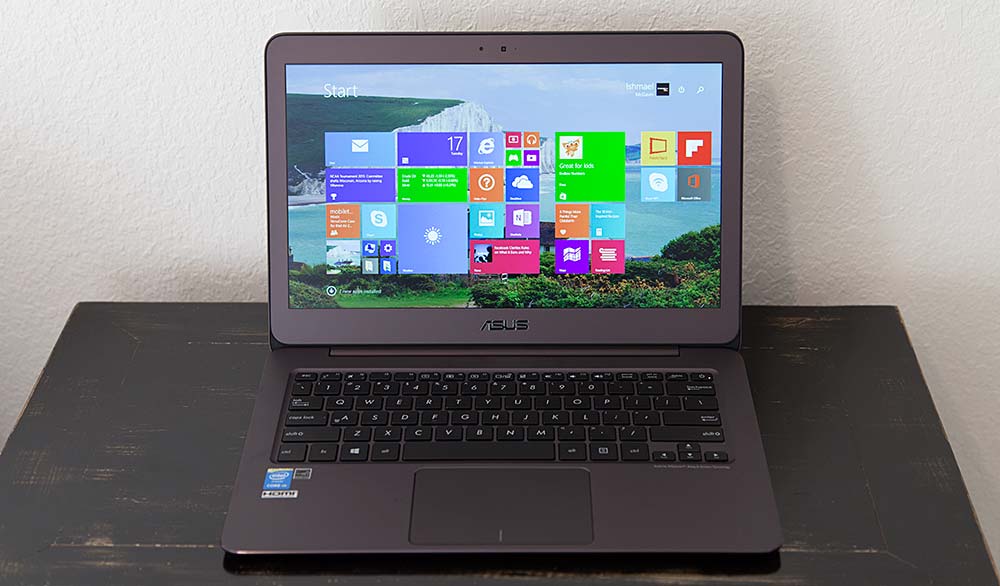
We need more machines like the Asus Zenbook UX305:
stylish, highly portable, quite capable and priced at just $699. We
were already impressed with Asus' $899 Zenbook UX303
that was recently refreshed with Intel Core i5 Broadwell CPUs. The
UX305 is the more affordable version of the UX303 (higher numbers don't
always mean better in Asus' world). But the key point here is that Asus
cut very few corners to create the $200 less expensive UX305. You do
give up the touch screen, which is the biggest drawback given Windows
8.1's push to use touch, but since it's a pure laptop form factor with
no convertible-tablet feature, we'll forgive it. Instead of the Intel
Core i5 used in the UX303, the UX305 has the lower power and slower
Intel Core M CPU, and the UX305 loses the backlit keyboard. But there's
plenty of goodness left: an all metal casing with Asus' signature
swirled aluminum lid, plenty of ports, a striking and slim design, and a
full HD 1080 matte IPS display (QHD 3800 x 1800 will be available in
April 2015 for $999).
Design and Ergonomics
The Asus Zenbook UX305 is a traditional
laptop that looks quite similar to previous Zenbook models, from the
swirled aluminum lid to the tapered side view. The UX305 particularly
reminds us of the 13" MacBook Air
with a similar lid and hinge design, a large metal bezel and a keyboard
that's a lot like the Air's (that's not a bad thing even though we wish
Asus would stop placing the power button where the delete key should
be, as does Apple). The entire external casing is made of metal,
including the bottom panel that's affixed with several torx T5 screws
and two Phillips head screws hidden under the back rubber feet. The
metallic plum color is a mix of blue and purple, which isn't my favorite
look, but color preference is personal. We've seen Asus use silver,
gunmetal, champagne and black on other Zenbook models; clearly they're
not afraid of playing with hues. The machine is rigid and we couldn't
twist or torque it. If you press really hard on the keyboard deck, it
will flex, but it's hard to imagine anyone would apply that much
pressure when typing.
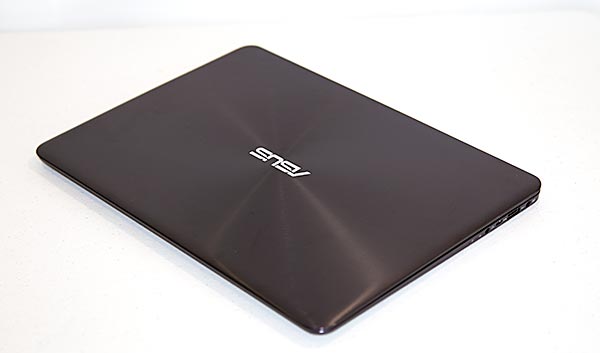
Despite its impressive slimness, the
Zenbook UX305 has a healthy selection of ports for a 13.3" Ultrabook: 3
USB 3.0 ports, micro HDMI, 3.5mm combo audio, an SD card slot and
Gigabit Ethernet via the included USB 3.0 to Ethernet dongle. We'd give
Asus a hard time about micro HDMI but there really isn't room for a full
size HDMI port and compared to the single port 12" MacBook
with which it competes on some fronts, it's doing just fine. Asus
includes their usual square charger with a relatively short and thin
cord. The UX305 is an attractive looking laptop for the price, though it
doesn't hit quite the high note that some more expensive Zenbook models
do, since there's less attention to esthetic detail like the flat-cut
stainless steel look on the sides of the UX303 or the glass lid of the
UX301. But for $699, it's wildly good looking and it keeps up nicely
with machines priced considerably higher.
The Intel Core M doesn't require a fan,
so the UX305 doesn't have one. That means the laptop is always dead
silent, and happily we didn't see significant thermal throttling when
the Zenbook worked on heavy loads like Benchmarks and gaming with Skyrim
for 30 minutes. The bottom doesn't get hot, but the strip just above
the keyboard does get warm to hot--fortunately that's not a place most
of us touch often.
Trackpad and Keyboard
The good news first: the keyboard is
very good and not noticeably different from the UX301 and UX303, both of
which had keyboards we thoroughly enjoyed. Asus might not employ
ergonomically shaped keys like Lenovo with their ThinkPads and Dell in
the XPS line, but I typed well with the Zenbook UX305. It has 1.2mm key
travel, which is a little lower than the 1.5mm travel of larger and
thicker laptops, but par for the course with a slim 13" Ultrabook.
Unlike most Zenbooks, the keyboard isn't backlit; something had to go to
meet the low price point. Happily the black keys and white masking are
easy to see even in dim rooms.
The trackpad is fairly large (almost as
big as the MacBook Air 13"), and we have the Microsoft Signature Edition
that avoids Asus' sometimes tepid drivers. Still, the trackpad was
passable but nothing more. It was reliable and didn't skip or falter,
but it sometimes missed touches when we tapped, didn't always register
two-finger scrolls and the click is loud.... loud enough that my
colleague turned to stare at me (granted that's happened with some
ThinkPads too). It's not a horrid trackpad, but it's not among the best.
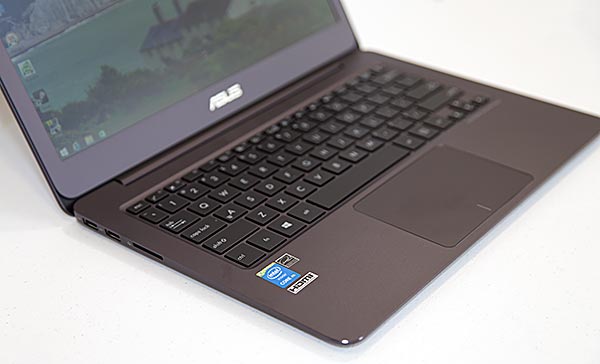
Display
Our $699 model has a 1920 x 1080 IPS
matte display. I love matte displays--the much reduced glare doesn't
induce eyestrain, and you can set the brightness lower since there's no
need to combat reflections. The bad news is that there's no touch screen
option, so those of you who actually enjoy using touch in Windows 8.1
are out of luck. Since this is a traditional laptop that doesn't convert
into a tablet, it's not an outright necessity, and it did allow Asus to
price the UX305 lower. Asus will offer a $999 version with a QHD 3200 x
1800 display in the future, and we'll be interested to see how much it
taxes the Core M CPU and Intel HD 5300 graphics.
Like most things in this world, IPS
displays come in different qualities, and this isn't the lovely matte
non-touch display of the $1,800 MSI Ghost Pro full HD or even that of
the UX303. It has noticeable light bleed when displaying dark
backgrounds and when booting up. We could see bleed all along the bottom
edge and the lower sides that extended about 1.5" toward the center of
the display. For those who aren't familiar with the term, light bleed is
when the white backlight bleeds out around the edges of the screen,
resulting in lighter areas that you'll notice when watching a
letterboxed movie. It's not bad enough to affect colorful desktop
wallpapers, photos or full screen video playback that has no
letterboxing. Again, for the price, we're not going to complain too
much, especially when we've seen more expensive Asus models with
backlight bleed at the same level a few years back.
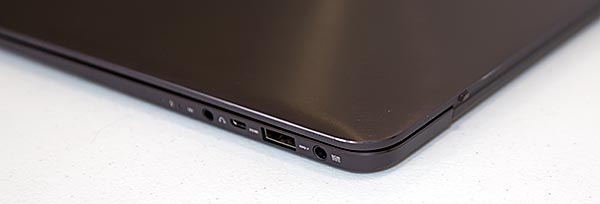
The display is fairly bright at 294
nits, and contrast is decent at 500:1 but not stellar (gloss panels tend
to deliver higher perceived contrast). Color gamut falls just a few
points below the $900 Ultrabook pack at 92% of sRGB, which is still
quite good overall and great for a laptop at this price point with a
host of good specs. Color calibration from the factory was wildly off,
making the panel look cool with excessive contrast (colors were a little
blown out). We've seen Asus put out panels with quite good calibration
(the UX303), and when they don't, they tend to be hiding panel
deficiencies (they're not the only manufacturer to do this). When we
calibrated the panel using our Spyder 4 Pro Colorimeter, brightness
dropped 10 nits but colors looked more natural and that slight solar
flare look was gone.
Performance and Horsepower
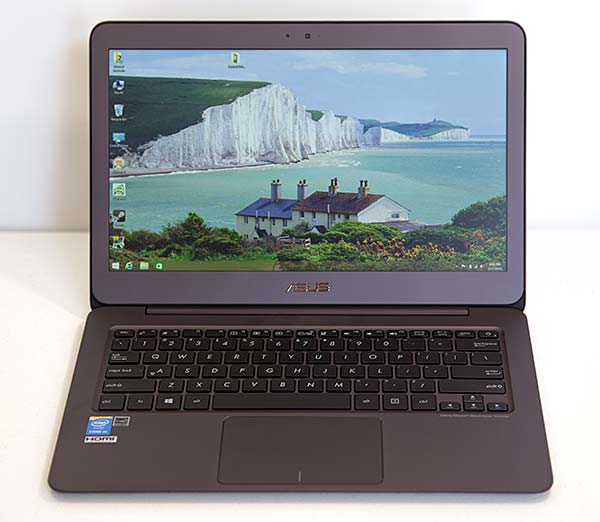 Here's the section many of you were
waiting for. The Zenbook UX305 runs on the 5th generation Intel
Broadwell Core M CPU rather than the more common Core i5 and i7 CPUs
used in Ultrabooks. The Core M is the evolution of the Y series CPU in
4th gen generation Haswell, and it was intended for Windows tablets and
11" laptops. It's paired with Intel HD 5300 graphics rather than the HD
5500 used with the Core i3, i5 and i7 Broadwell CPUs. No, it's not the
sharpest knife in the drawer, but Asus is always good at performance
tuning and that, coupled with 8 gigs of RAM and a quick SSD, mean that
the Zenbook UX305 never felt balky or sluggish when doing everyday tasks
like web browsing with 5-10 tabs open in IE, MS Office, email, social
networking and streaming 1080p video. It feels quicker than the more
expensive Lenovo Yoga 3 Pro that uses a slightly higher clocked version
of the Core M, and we suspect this has much to do with drivers and good
hardware tuning. The 800 MHz (no, that's not a typo, we're back in
megahertz land here) has Turbo Boost to 2 GHz, and that helps it feel
quick--the CPU can ramp up clock speeds for short bursts as needed to
handle demand. Of course, this has its limits, and the UX305 isn't our
pick for those who need to accomplish more challenging work like
frequent 1080p video editing and encoding, compiling tens of thousands
of lines of code for software development, or juggling a few concurrent
VMs. It's an everyday productivity machine, not a powerhouse. It's also
not a great pick for those of you who want to run recent 3D games in the
desktop environment (Metro Live Tile games are fine, though
touch-oriented ones won't be a joy here). We tested a few games and we
demo Skyrim in our video review. It managed only 22 fps at 1366 x 768
with all settings at low except textures which was set to medium (AA was
off). When we dropped textures to low the game was a more playable 30
fps, though it didn't look great at that low a resolution and quality
setting combo. If you need more horsepower, Asus is hoping you'll
consider the $899 Zenbook UX305 instead (of course Dell would like you
to think of the XPS 13).
Here's the section many of you were
waiting for. The Zenbook UX305 runs on the 5th generation Intel
Broadwell Core M CPU rather than the more common Core i5 and i7 CPUs
used in Ultrabooks. The Core M is the evolution of the Y series CPU in
4th gen generation Haswell, and it was intended for Windows tablets and
11" laptops. It's paired with Intel HD 5300 graphics rather than the HD
5500 used with the Core i3, i5 and i7 Broadwell CPUs. No, it's not the
sharpest knife in the drawer, but Asus is always good at performance
tuning and that, coupled with 8 gigs of RAM and a quick SSD, mean that
the Zenbook UX305 never felt balky or sluggish when doing everyday tasks
like web browsing with 5-10 tabs open in IE, MS Office, email, social
networking and streaming 1080p video. It feels quicker than the more
expensive Lenovo Yoga 3 Pro that uses a slightly higher clocked version
of the Core M, and we suspect this has much to do with drivers and good
hardware tuning. The 800 MHz (no, that's not a typo, we're back in
megahertz land here) has Turbo Boost to 2 GHz, and that helps it feel
quick--the CPU can ramp up clock speeds for short bursts as needed to
handle demand. Of course, this has its limits, and the UX305 isn't our
pick for those who need to accomplish more challenging work like
frequent 1080p video editing and encoding, compiling tens of thousands
of lines of code for software development, or juggling a few concurrent
VMs. It's an everyday productivity machine, not a powerhouse. It's also
not a great pick for those of you who want to run recent 3D games in the
desktop environment (Metro Live Tile games are fine, though
touch-oriented ones won't be a joy here). We tested a few games and we
demo Skyrim in our video review. It managed only 22 fps at 1366 x 768
with all settings at low except textures which was set to medium (AA was
off). When we dropped textures to low the game was a more playable 30
fps, though it didn't look great at that low a resolution and quality
setting combo. If you need more horsepower, Asus is hoping you'll
consider the $899 Zenbook UX305 instead (of course Dell would like you
to think of the XPS 13).
Battery Life
Intel Core M is supposed to be all
about better battery life since it's a 4.5 watt CPU vs 15 watts for U
series Intel Core i3/i5/i7 U series CPUs. Broadwell itself focuses on
battery life improvements, and while we've seen those materialize in the
first Broadwell machines, we haven't seen Core M significantly beat the
higher powered Core i5. So our expectations weren't very high for the
UX305 and its 45 Wh battery, but we were pleasantly surprised by its 9
hour average battery life (that's actual use time, not sleep time). In
our real life tests using the laptop for web browsing with 5-10 tabs
open, working in MS Office, streaming an hour of House of Cards in 1080p
via Netflix, watching several short YouTube videos and editing 10 RAW
files in Photoshop CC, all with WiFi on and brightness set to 50%, our
unit averaged 8-9 hours. That's a very respectable number for a 13"
Windows laptop, and only the non-touch full HD Dell XPS 13 and the
MacBook Air beat it among Intel-based portables.


0 comments